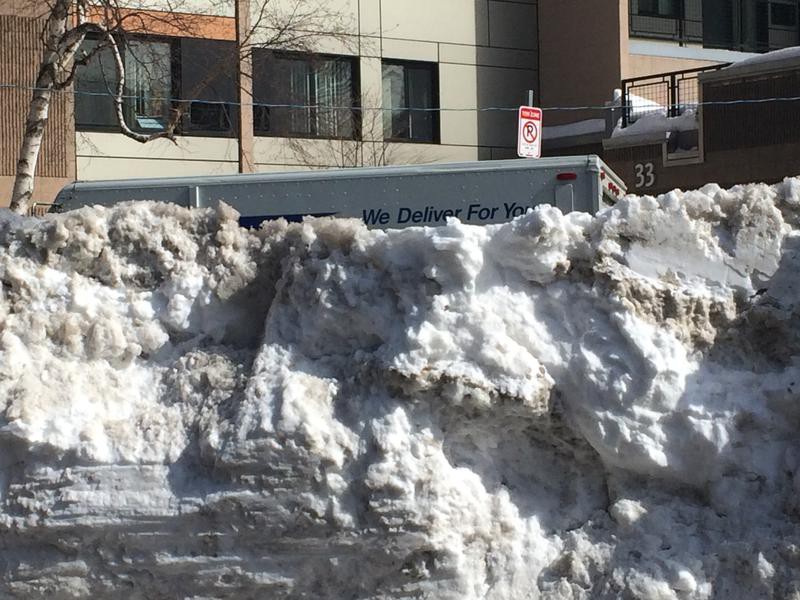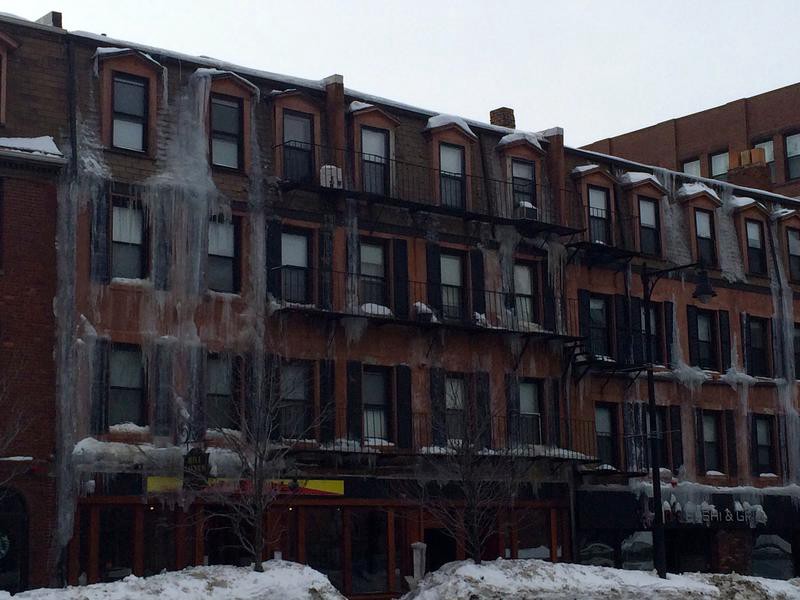

It’s been two weeks since the last real winter storm in Boston. But snow piles six or seven feet high still divide streets down their centers and wall off curbs, the sidewalks nothing more than icy, single-step foot paths. More snow is on its way tonight, threatening to push the city’s current 104-inch accumulation past its snowiest winter on record at just over 107. And there’s no where to put it.
We often conceive of disasters as short and sharp. Hurricane, fire, or flood. They hit and go. We survey the damage and get to work.
But what about those more slow-burning (or in Boston’s current case, slow-freezing) catastrophes? A tempered crumbling over months as temperatures never warm, the snow never melts, public transportation slows to a literal halt, and local businesses remain unopened for days at a time. The snow which piles up. The drought that never ends. The flood waters on the rise. The heat that just won’t drop.
As Boston works out how to deal with the millions spent on snow removal and the $265 million lost to the state and its residents each day a major storm shut it down this winter, now is the time to talk about a new currency in the city–resilience.
It’s a term particularly relevant to Boston and the 15 other U.S. cities recently selected by the Rockefeller Foundation’s 100 Resilient Cities project. The initiative, which grants core offerings that amount to well over $1 million in foundation support, installs a chief resilience officer in each city tasked to work with local officials, academia, and business communities to identify what Rockefeller’s Resilient Cities COO Andrew Salkin calls different types of “shocks and stresses.”
Salkin defines their resilience as holistic in approach, one that uses the people and systems already in place not only to survive and adapt, but to grow and become better. Critics of the new urban buzzword, of which there are a vocal few, hear resilience and instead think ever more endurance by those already disenfranchised and suffering–a hoist yourself up by your bootstraps mentality that just feels tired. Or, they hear top-down investment and think gentrification.
The 100 RC method seems more empathetic than that: As in, let’s appreciate the reasons why people in cities find it harder to cope with certain shocks as a result of larger, endemic problems they can’t control themselves. “Cities need to figure out how to have so many people living in such small spaces in a way that prevents pain and damage,” Salkin told me.
As urban populations grow, cities globally face both the need for swift recovery from quick shocks and the ability to recognize more chronic stresses. Such stresses can include violence or job shortages–or recurring weather effects that transition from acute to ongoing.
“You wouldn’t compare crime and violence to snow removal, but maybe they actually can be thought of in the same way,” said Maxwell Young, vice president of communications and marketing at 100 RC. “You could say the same thing for [what become] chronic food and water shortages, or flooding. Slow-burning stresses that become real crises.”
Salkin added, “What Boston’s facing right now is, in many ways, a compounding of these snowstorms. Each storm in and of itself isn’t significant; what’s significant is that the storm hasn’t melted.” The weather’s surprising staying power amounts to more than just snow in the streets; it has exposed many of the city’s social and infrastructure failings.

When cities talk about emergency plans based around hurricanes, power outages or economic bubble-bursts, they talk about them in silos. Part of Salkin’s strategy is to help them deal with shocks and stresses in tandem, yielding multiple benefits from single investments.
El Paso, Texas, a desert community where rain comes sparingly but quickly, faced a regular flash-flooding problem. With the help of 100 Resilient Cities, the city built dry ponds, or places to collect water while other systems drained. But since the ponds are in use only about five days a year, they’ve been programmed as skate parks and soccer fields.
In Medellín, Columbia, another of Rockefeller’s resilient cities, violence-for-hire by a local drug cartel sustained a remote hillside community over an hour’s walk from the town below. “To combat the violence, what they really needed to do was combat the underlying stress that created the violence, which was access to jobs. The way you get access to jobs is you build better transportation,” said Salkin. The city installed gondolas running up into the hills with plazas at each stop, effectively linking people to the business district below while creating community gathering places.
Aside from cities like Medllín, Salkin said, “People ask us a lot, why are you working with these effectively wealthy and well-off cities? What we’re seeing right now in Boston is exactly that story of why. Just because a city is wealthy doesn’t mean [it] understands how [its] stresses and shocks are interrelated. If cities aren’t able to recognize changes and take action around that they’ll miss huge opportunities to make themselves relevant in the future.”
He cites Detroit, which once had the highest per capita income of any city in the United States. “Let me point out that the largest failure of a city in the United States was caused because of a stress “¦ an overreliance on one industry.” Wealthy or not, he believes that cities can share best and worse practices with each other. “Hopefully we’ll create blueprints for the rest of the world.”
Boston will surely have to deal with snow again. It’ll be one agenda item among a wide range of issues: a fragile and failing public transportation system, changing sea levels and race relations.

Salkin said Boston is primarily interested in addressing some decisions born out of the 1970s that led to isolating certain demographics, cutting off access for those people from jobs and education and creating a city of physical and social barriers. From some 650 cities that applied, it was a lofty enough goal to land Boston among 66 other partner cities, with the final application challenge to reach 100 coming this fall.
There’s a lot to learn in Boston from this winter, way beyond the snow. Salkin hopes we may look at the urban space anew. “In many ways a snowstorm, more than any other event, impacts the space between buildings–the space the city controls–in a very deliberate way. What you’ve seen is how that space can get compromised. But it also shows you what spaces you do need and what spaces you don’t.” A snowstorm, in effect, offers a blanketed canvas.


How We Get To Next was a magazine that explored the future of science, technology, and culture from 2014 to 2019. This article is part of our Metropolis section, on the way cities influence new ideas–and how new ideas change city life. Click the logo to read more.
